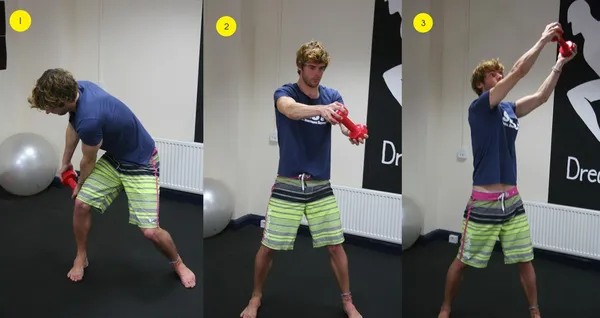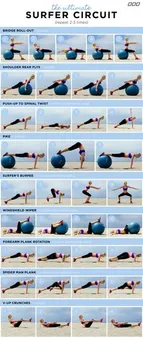Table of Contents
Are you eager to elevate your surfing skills and conquer the waves like a pro? At Kizworld, we've compiled a comprehensive guide to The best surfing exercises and workouts that will transform you into a confident and capable surfer. Discover the secrets to enhancing your balance, strength, and endurance, both in and out of the water. Get ready to ride the waves with grace and style as we unveil the ultimate training regimen tailored for surfers of all levels.
I. The Best Surfing Exercises and Workouts for Beginners
The Best Surfing Exercises and Workouts for Beginners
Surfing is a great way to get exercise, have fun, and enjoy the outdoors. But before you hit the waves, it's important to make sure you're in good shape. That means having the strength, endurance, and flexibility to paddle, pop up, and ride the waves. The best surfing exercises and workouts will help you develop these qualities so you can enjoy your time in the water to the fullest.
The Best Surfing Exercises
There are a variety of exercises that can help you improve your surfing skills. Some of the best exercises include:
- Paddling: Paddling is the most important part of surfing, so it's important to have strong arms and shoulders. You can improve your paddling strength by doing exercises like swimming, kayaking, and rowing.
- Popping up: Popping up is the act of standing up on your surfboard. It requires a combination of strength, balance, and coordination. You can improve your pop-up technique by doing exercises like squats, lunges, and push-ups.
- Riding the waves: Riding the waves is the most fun part of surfing, but it also requires a lot of skill. You need to be able to balance on your board, control your speed, and turn. You can improve your riding skills by practicing in small waves and gradually working your way up to bigger waves.
The Best Surfing Workouts
In addition to doing specific surfing exercises, you should also incorporate general fitness workouts into your routine. These workouts will help you improve your overall strength, endurance, and flexibility. Some of the best surfing workouts include:
- Cardio: Cardio exercises like running, swimming, and biking will help you improve your endurance so you can paddle longer and ride more waves.
- Strength training: Strength training exercises like squats, lunges, and push-ups will help you build muscle and improve your strength so you can paddle harder and pop up more easily.
- Flexibility training: Flexibility training exercises like yoga and stretching will help you improve your flexibility so you can move more easily on your board and avoid injuries.
How to Get Started
If you're new to surfing, it's important to start slowly and gradually work your way up to more challenging workouts. You should also make sure to warm up before each workout and cool down afterwards. And most importantly, have fun! Surfing is a great way to get exercise, enjoy the outdoors, and make new friends.
Here are some additional tips for beginners:
- Take a lesson: If you're new to surfing, it's a good idea to take a lesson from a qualified instructor. This will help you learn the basics of surfing and avoid bad habits.
- Start in small waves: When you're first starting out, it's best to surf in small waves. This will help you get a feel for the sport and avoid getting overwhelmed.
- Be patient: Surfing takes time and practice to learn. Don't get discouraged if you don't catch a wave right away. Just keep practicing and you'll eventually get the hang of it.
Surfing is a great way to get exercise, have fun, and enjoy the outdoors. By following these tips, you can improve your surfing skills and make the most of your time in the water.
If you're looking for more information on surfing, check out these related posts:
- How to Choose the Right Surfboard for Your Skill Level and Style
- The Benefits of Surfing for Fitness and Fun
- The Best Surfing Equipment and Accessories
II. Essential Exercises for Intermediate Surfers
Essential Exercises for Intermediate Surfers
Paddle Power and Fitness
- Paddling Interval Workout: Alternate between high-intensity paddling for 30 seconds and rest or light paddling for 60 seconds, repeated for 10-12 cycles.
- Pool Paddling: Practice paddling in a pool using a surfboard or resistance paddle to build paddling strength and technique.
- Dry Land Paddling: Use a paddling machine or perform exercises like the prone paddle pull and kneeling paddle drive to improve paddling power.
Core Stability and Balance
- Plank: Hold a plank position for 30-60 seconds, progressing to longer holds and variations like the side plank.
- Superman: Lie on your stomach, extend your arms and legs, and lift your chest, head, and legs off the ground, hold for a few seconds, and then relax.
- Bird Dog: Start in a tabletop position, then extend your right arm and left leg, hold for a few seconds, and then switch sides.
Leg Strength and Mobility
- Squats: Perform bodyweight or weighted squats to build leg strength and improve balance.
- Lunges: Do forward and reverse lunges to work your quads, hamstrings, and glutes.
- Calf Raises: Strengthen your calves by performing calf raises on a step or curb.
Upper Body Strength and Endurance
| Exercise | Sets | Reps | Notes |
Push-ups | 3-4 | 8-12 | Use proper form, progressing to variations like incline or decline push-ups. |
Pull-ups or Lat Pull-downs | 3-4 | 8-12 | Use a pull-up bar or lat pull-down machine, focusing on good form. |
Shoulder Press | 3-4 | 8-12 | Use dumbbells or a shoulder press machine, keeping your core engaged. |
Flexibility and Mobility
- Yoga: Practice yoga poses that focus on flexibility, balance, and core strength, such as the downward dog, the warrior pose, and the pigeon pose.
- Foam Rolling: Use a foam roller to release muscle tension and improve flexibility in your legs, back, and shoulders.
- Stretching: Regularly stretch your major muscle groups, especially your hamstrings, quads, shoulders, and back, to prevent tightness and improve range of motion.
Cardio for Endurance
- Running: Go for regular runs or jogs to improve your cardiovascular health and endurance.
- Swimming: Swimming is a great way to build endurance and work your entire body.
- Cycling: Cycling is a low-impact exercise that can help you improve your cardio and endurance.
III. Advanced Surfing Exercises and Workouts
Advanced Surfing Exercises and Workouts
Explosive Power Exercises
- Box Jumps: Improve leg power and explosiveness.
- Medicine Ball Slams: Develop core strength and power.
- Kettlebell Swings: Enhance hip power and explosiveness.
These exercises help surfers generate the power needed for explosive maneuvers like aerials and cutbacks. Incorporate them into your routine 2-3 times per week.
Balance and Coordination Exercises
- Single-Leg Squats: Improve balance and stability.
- BOSU Ball Squats: Challenge balance and coordination.
- Yoga: Enhance overall balance and body awareness.
Surfing requires excellent balance and coordination. These exercises help surfers maintain control and stability on the board. Aim for 2-3 sessions per week.
Core Strength Exercises
- Planks: Strengthen the core and improve stability.
- Crunches: Target the abdominal muscles.
- Side Planks: Strengthen the obliques and improve core stability.
A strong core is essential for surfing. It helps surfers maintain proper form, generate power, and prevent injuries. Dedicate 2-3 sessions per week to core exercises.
Flexibility and Mobility Exercises
- Foam Rolling: Release muscle tension and improve flexibility.
- Stretching: Improve range of motion and prevent injuries.
- Yoga: Enhance overall flexibility and mobility.
Flexibility and mobility are crucial for surfers to perform complex maneuvers and avoid injuries. Incorporate these exercises into your routine 2-3 times per week.
Cardiovascular Exercises
- Running: Improve cardiovascular endurance.
- Swimming: Enhance cardiovascular health and endurance.
- Cycling: Build cardiovascular fitness and leg strength.
Cardiovascular exercises help surfers maintain endurance and energy levels during long surf sessions. Aim for 3-4 sessions per week.
Remember, consistency is key when it comes to improving your surfing skills. Dedicate time to these exercises and workouts regularly to see significant progress in your surfing.
For more information on surfing exercises and workouts, check out our related articles:
- The Best Surfing Exercises and Workouts
- How to Improve Your Balance, Coordination, and Endurance with Surfing
- The Best Surfing Apps and Websites
IV. Additional Tips for Improving Your Surfing Skills
Additional Tips for Improving Your Surfing Skills
Looking for additional ways to improve your surfing skills? Here are a few final tips to help you on your journey to becoming a wave-riding pro:
Stay hydrated. Surfing can be a physically demanding activity, so it's important to stay hydrated by drinking plenty of water. You should aim to drink 8 glasses of water per day, but if you're going to be surfing you'll need even more. Dehydration can lead to fatigue, headaches, and muscle cramps, so make sure you're drinking enough fluids to stay healthy.
- Learn more: How to Do A Handstand
- Related: The Benefits Of Gymnastics For Kids
Get enough sleep. Most adults need around 7-8 hours of sleep per night. When you're not getting enough sleep, you're more likely to make mistakes and get injured. Make sure you're getting enough rest so that you can perform at your best in the water.
Cross-train. Cross-training with other activities that work different muscle groups can help you improve your strength and balance and reduce your risk of injury. Some good options include swimming, biking, running, and yoga. Cross-training can also help improve flexibility, endurance, and cardio.
- Learn more: How To Choose The Right Martial Art For You
- Related: The Benefits of Martial Arts For Physical And Mental Health
Use video to analyze your technique. Record yourself surfing and then watch the video back to see where you can improve. Pay attention to your form, your positioning on the board, and your timing. You can learn a lot by watching yourself surf, and it's a great way to identify areas where you need to improve.
Tip | Benefit |
|---|---|
Stay hydrated | Prevents fatigue, headaches, and muscle cramps |
Get enough sleep | Improves focus and decision-making |
Cross-train | Improves strength, balance, and flexibility |
Use video to analyze your technique | Helps you identify areas where you need to improve |
Don't be afraid to ask for help. If you're struggling to improve your surfing skills, don't be afraid to ask for help from a more experienced surfer or a surf instructor. They can help you identify areas where you need to improve and give you tips on how to progress your skills.
- Learn more: How To Choose The Right Surfboard For Your Skill Level And Style
- Related: The Benefits Of Surfing For Fitness And Fun
V. Conclusion
To maximize your surfing performance and stay safe in the water, incorporating these exercises and workouts into your routine is essential. By strengthening your core, improving your balance, and enhancing your endurance, you'll be well-prepared to catch waves, paddle efficiently, and maintain control of your board. Remember, consistency is key, so make these exercises a regular part of your training regimen. With dedication and practice, you'll notice significant improvements in your surfing skills and overall enjoyment of the sport.